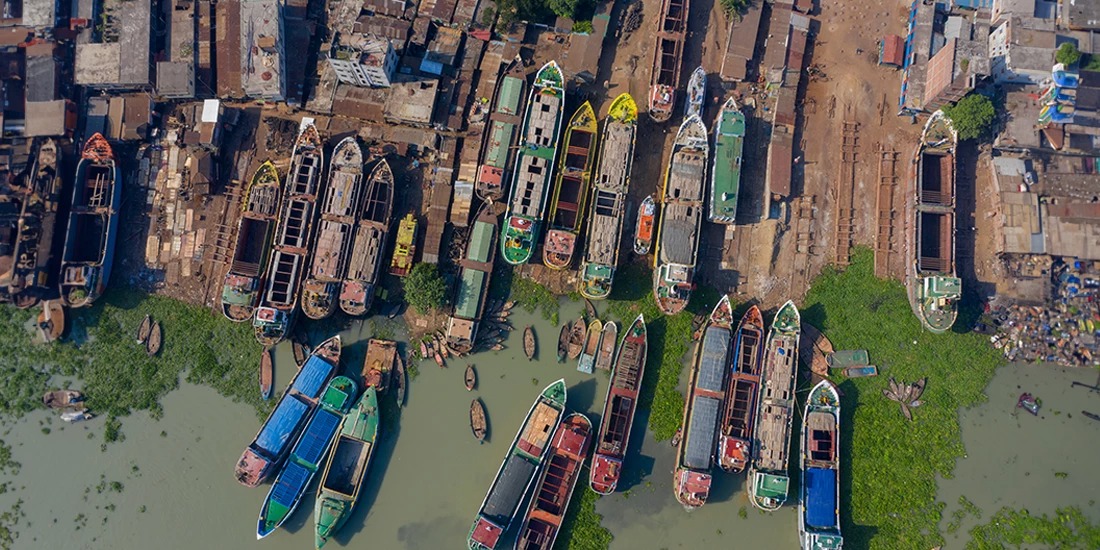As growing economic activity continues to boost the demand for freight transport, what if there was a way to move goods around that didn’t involve putting more trucks on the road and creating more congestion? What if we could carry large quantities of grain, minerals, containers, and other commodities from production centers to ports and other transit hubs for export? What if we could achieve all this with lower logistics costs and lower carbon emissions?
While it may sound ambitious, this vision could certainly become reality. But it requires one major shift: countries will need to transfer a portion of freight traffic from roads to inland waterways such as rivers, lakes, and canals.
Inland waterways make up about 5% to 10% of inland freight traffic in the US, the European Union and China, with trucking being the dominant mode globally. Yet in many parts of the world, they could play a much bigger role in the transport chain. Imagine the potential of famous rivers such as the Mississippi, the Rhine, the Mekong, the Brahmaputra, the Yangtze, the Nile and the Amazon, and many more inland waterways.
The potential benefits are hard to overstate. When done right, inland water transport (IWT) provides a unique chance to make transport:
- Greener: Greenhouse gas emissions from heavy trucking have been growing rapidly, and can sometimes account for up to 40% of a country’s transport emissions. Shifting more cargo onto IWT would be a powerful way to buck the trend, with IWT emitting up to six times fewer emissions than trucks per ton-km.
- Cheaper: One major advantage of IWT is that it consolidates cargo on large vessels instead of individual trucks. In fact, an IWT vessel can carry a few hundred containers, equivalent to a few hundred trucks. This allows for substantial economies of scale, resulting in transport costs per ton-km that can be several times less than that of trucking.
- Safer: Although carrying cargo via IWT may require longer lead times compared to trucking, the risk of a serious collision or other incidents is considerably lower on the water. As a result, some studies have found IWT to be up to 50 times safer in terms of fatalities per ton-km.
Building on this, the World Bank has been working with client countries across several regions to unlock the potential of IWT and make it an integral part of the broader transport system. Our efforts to boost IWT have focused on several key priorities:
- Financing: Channelling adequate financing toward IWT has been an uphill battle. In emerging economies, transport budgets are often constrained and roads usually claim the lion’s share. Even in countries that are blessed with extensive waterway systems, the IWT sector is underfunded and typically receives only a small fraction of the total transport budget. We are actively working with clients to turn this around.
- Complementary infrastructure: Just like other transport systems, IWT requires complementary infrastructure. For example in Viet Nam, in addition to the upgrading of waterways for larger vessels to navigate, the World Bank is helping invest in and develop complementary ports, access roads, higher bridges for larger vessels, multi-modal connections, as well as navigation locks and maritime access channels to connect the waterways to the seas and coastal ports for international trade.
- Policy: Besides policies to guide operations and safety, we have been working with transport authorities to adopt international good practices that are conducive to more sustainable transport such as IWT. These include establishing a transport strategy for multi-modal integration, facilitating data exchange across transport modes for more seamless connections, encouraging transport companies to consider IWT and other sustainable modes, better coordinating scheduled vessel services, and consolidating cargo on vessels to reduce the costs and emissions associated with individual trucks.
In the face of soaring transport demand, it may be tempting to keep the status quo and to continue building upon the current model: more roads, more trucks, more congestion, more greenhouse gas. However, our analytical work and experience from the field show that inland waterway transport can provide a realistic alternative that would make freight transport greener, cheaper, and safer. It’s hard to imagine why countries would want to miss out on this, especially in a context where governments are scrambling to curb climate emissions and diversify their supply chains. From Bangladesh to China to Viet Nam, our team is proud to help clients harness the power of IWT, and is excited to explore similar opportunities in other countries around the world.


